Howey is a small village sat about 1.5 miles south of Llandrindod Wells, on the road to Built Wells. Within the village is St. George’s Parish Church, which contains a war memorial to its parishioners who fell during both World Wars. Oddly, the memorial not note which war each man fell in, so has taken a bit of sorting out.
The Great War, 1914-1918
Matthew Thomas Cadwallader, Private, 235405, South Lancashire Regiment. Matthew was the son of Richard and Mary Cadwallader, of Kinlet Villa, Howey. He enlisted into the Herefordshire Regiment, and after training was posted to the 11th Battalion, South Lancashire Regiment, which was the Pioneer Battalion to the 30th Division. The Division had moved to France in November 1915, and took part in its first major action during the Somme Offensive. During March 1917 the Division followed the German Retreat to the Hindenburg Line, and in April took part in the Battle of Arras. Later that year the division moved north to Ypres, and fought at the Battle of Pilckem. At the beginning of 1918 the Division was stationed near St. Quentin, and when the Germans launched their Offensive here on 21 March, the Division took part in a desperate rearguard action before being relieved and moved to the Lys to rest and rebuild. Unfortunately the division became caught up in fierce fighting following the Germans second offensive, on the Lys, which began on 9 April 1918. Matthew was captured by the Germans during this tumultuous period and taken to a prison camp in Germany where he died on 16 May 1918, aged 26. He is buried in Berlin South-Western Cemetery, Germany.
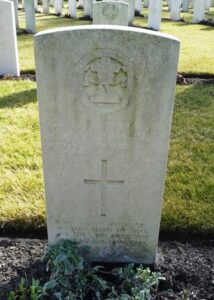
David Davies, Private, 27729, Border Regiment. David was the son of John and Tryphena Davies, of 3, New Row, Howey. He enlisted at Llandrindod Wells into the 1st Battalion, Herefordshire Regiment, but was then transferred to the 3rd Battalion, King’s Shropshire Light Infantry. David was posted to France in 1916, and joined the 11th (Lonsdale) Battalion, Border Regiment, which was attached to 97 Brigade, 37th Division. The division saw heavy fighting on the Somme in 1916, and wintered there before moving to the Arras sector in March 1917. David was taken prisoner prior to the Battle of Arras, possibly on 18 February 1917. He died of general debility whilst in captivity, on 21 May 1917, aged 34. David is buried in Valenciennes (St. Roch) Communal Cemetery, France.
Arthur Davenport, Private, 41734, South Wales Borderers. Arthur was born in Mountain Ash on 26 December 1898, the son of Joseph and Jane Davenport. His mother died in 1901 and his father had moved, together with Arthur and his brother Ernest, to 6, Upton Street, Penygraig by 1911. Prior to the outbreak of war, the family was living at New Road, Howey, where their eldest sister was living with her husband. Arthur enlisted at Neath into the army and was posted to France early in 1918, joining the 6th Battalion, South Wales Borderers. The battalion was the Pioneer Battalion to the 30th Division and had taken part in the Battle of Passchendaele the previous year, before moving to the Somme, near the St. Quentin area, at the beginning of 1918. The division came under heavy attack there when the Germans launched their Offensive here on 21 March, and fought for several days during a brave rearguard action. The division was then withdrawn to rest and moved to Flanders, but again became caught up in heavy fighting when the Germans launched their second offensive along the Lys on 9 April. From 21 August onwards the division played a part in the great 100 days offensive, taking part in the Advance in Flanders. Arthur was wounded during the Battle of Courtrai some weeks later and died of his wounds at Sangatte on 28 October 1918, aged 19. He is buried in Les Baraques Military Cemetery, Sangatte, France. Both his brothers also fell.
Ernest Davenport, Private, 11046, South Wales Borderers. Ernest was born at Newbridge-on-Wye on 28 November 1893, the son of Joseph and Jane Davenport. His mother died in 1901 and his father had moved, together with Ernest and his brother Arthur, to 6, Upton Street, Penygraig by 1911. Prior to the outbreak of war, the family was living at New Road, Howey, where their eldest sister was living with her husband. Ernest enlisted into the 1st Battalion, South Wales Borderers prior to the outbreak of war. He embarked for France with the battalion on 13 August 1914, taking part in the retreat from Mons and the subsequent Battles of the Aisne and Marne. He was wounded on the Aisne and after recovering re-joined the battalion in Flanders, where he was again wounded. Ernest then became ill and was discharged from the army as medically unfit on 1 February 1916 after having been diagnosed as suffering from tuberculosis. He died of tuberculosis at Mardy Hospital, Merthyr on 11 August 1917, aged 22 and was buried in All Souls Churchyard, Newbridge-on-Wye. Ernest is not commemorated by the CWGC. His two brothers also fell.
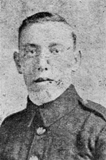
Leonard Joseph Thomas Davenport, Lance Corporal, 10428, South Wales Borderers. Leonard was born at Mountain Ash on 31 March 1891, the son of Joseph and Jane Davenport. His mother died in 1901 and his father had moved, together with his two brothers, to 6, Upton Street, Penygraig by 1911. Prior to the outbreak of war, the family was living at New Road, Howey, where their eldest sister was living with her husband. Leonard was by now serving in the army, being overseas with the 2nd Battalion, South Wales Borderers. He took part in the battalions’ assault against the German held garrison of Tsingtau following the outbreak of war, then returned to Britain with the battalion, where it joined 87 Brigade, 29th Division before taking part in the Gallipoli landings on 25 April 1915. The division was evacuated from Gallipoli in January 1916 and moved to Egypt before embarking for Marseilles and entraining for the Somme sector. Leonard took part in the divisions assault on Y-Ravine during the opening of the Battle of the Somme on 1 July 1916. He survived the divisions ordeals on the Somme, but was wounded within days of the divisions move to the Ypres sector in the summer of 1917. He died of his wounds at Ypres on 4 July 1917, aged 25, and is buried in Bard Cottage Cemetery, Belgium. His two brothers also fell.
William James Lloyd, Private, 235961, Herefordshire Regiment. William was the son of James and Elizabeth Lloyd, of Hill View, Howey. He lived and worked as a plumber at Hafod, Swansea prior to the war and returned to Llandrindod Wells to enlist into the 1st Battalion, Herefordshire Regiment. The battalion had served at Gallipoli with the 53rd (Welsh) Division, before being evacuated to Egypt on 12 December 1915. It then served with the division in Egypt, before taking part in the offensive into Palestine in 1917. William was taken prisoner by the Turks in Palestine, during one of the Battles of Gaza. He died of disease whilst a prisoner in Mesopotamia on 27 August 1917, aged 28, and is buried in Baghdad (North Gate) War Cemetery. His war gratuity was awarded to the mother of his illegitimate child, Christiana Francis, of Hafod, Swansea.
Sidney Price, Private, 18813, King’s Shropshire Light Infantry. Sydney was born at Disserth in 1891, the son of Susan Price. Susan was widowed by 1901 and became a lodging house keeper at 3 Denham Terrace, Llandrindod Wells. Sidney lived at Neath prior to the war and enlisted at Hereford into the 6th Battalion, King’s Shropshire Light Infantry. He served in France with the battalion until early in 1918, and then transferred to the 10th Battalion, KSLI, which arrived in France on 7 May 1918 with the 74th (Yeomanry) Division. Sidney was wounded when the battalion was in the line in L’Epinette on 22 August 1918, when the Shropshire’s were hit by a German counter-attack. He died that same day, aged 27, and is buried in Merville Communal Cemetery Extension, France.
Thomas Lewis Pugh, Serjeant, 7297, Welsh Regiment. Thomas was born at Garddu, Howey, the son of John and Mary Pugh. He lived with his wife Eleanor Pugh, at Bewdley House, Llandrindod Wells prior to the war. Thomas was an army reservist and following the outbreak of war joined the 8th Battalion, Welsh Regiment. The battalion had formed in Cardiff in August 1914, before moving to Salisbury Plain as part of the 13th Division. Thomas took ill here and returned to Llandrindod Wells, where he died on 4 April 1915, aged 28. He is buried in Providence Baptist Chapelyard, Howey. Thomas is not named on the Howey memorial.
Evan John Worthing, Gunner, 97679, Royal Garrison Artillery. Evan was the son of Joseph and Eliza Worthing, of Cefn House, Howey. He worked as a waggoner prior to enlisting into the Royal Artillery on 10 December 1915.Evan was not mobilised until 20 June 1916 when he joined the Royal Garrison Artillery and after training was posted out to France with the 152nd Siege Battery, RGA. The battery moved to Ypres and took up positions near the Ieperlee canal, where it began work softening up the German lines in preparation for the forthcoming Third Battle of Ypres. Evan was wounded at Ypres when his gun position was hit by German gas shells. He died at the 88th Field Ambulance on 18 July 1917, aged 20, and is buried in Canada Farm Cemetery, Belgium. His brother, William, had been killed at Ypres in 1915.
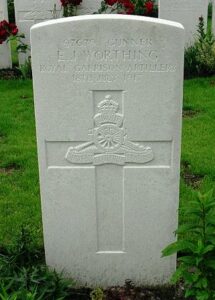
William Worthing, Private, 17437, King’s Shropshire Light Infantry. William was the son of Joseph and Eliza Worthing, of Cefn House, Howey. He worked as a waggoner prior to enlisting at Knighton into the 5th Battalion, King’s Shropshire Light Infantry soon after the outbreak of war. The battalion was attached to 42 Brigade, 14th (Light) Division, and landed at Boulogne on 25 May 1915. The Division was to see its first action during the Action of Hooge, where it became the first to be attacked by the German use of flamethrowers. It then fought in the Second attack on Bellewaarde. The battalion had been in the line near the Menin Road throughout August, and as a diversion to the main offensive at Loos which was to take place from 25 September 1915, the 14th Division had been given the task of attacking Bellewaarde. The 5th KSLI, together with the remainder of 42 Brigade, was tasked with seizing Bellewaarde Farm. The British launched an artillery bombardment at 3.50, then at 4.20 the attacking battalions advanced behind a creeping barrage. Some of the brigades objectives were reached, but a German counter-attack pushed them back to their starting positions, after incurring heavy casualties. William was among 450 casualties suffered just by the 5th KSLI that day. The 23-year-old has no known grave and is commemorated on the Menin Gate Memorial, Ypres. His brother, Evan, was killed at Ypres in 1917.
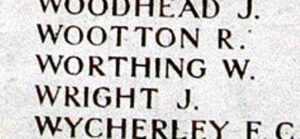
World War Two, 1939-1945
Peter Ablitt, Warrant Officer, 1375027, Royal Air Force Volunteer Reserve. Peter was the son of Ernest Harry Leverson Gower Ablitt and Blodwen Ablitt (nee Jones), of Llwynderw, Howey. He enlisted into the Royal Air Force Volunteer Reserve and trained as a pilot before being posted to 17 Squadron, RAF. The squadron had been in France with the BEF until the evacuation and then flew Hurricanes during the Battle of Britain. On 11 November 1941, the Squadron sailed for the Far East, and was diverted to Burma following the Japanese invasion of Burma. The squadron operated Hurricanes in Burma and India before being posted to Ceylon in February 1943, where it converted to Spitfires. Peter was killed when his Hurricane crashed whilst attempting to land at Colombo on 28 September 1944. He was 26 years old and is buried in Liveramentu Cemetery, Colombo, Sri Lanka.
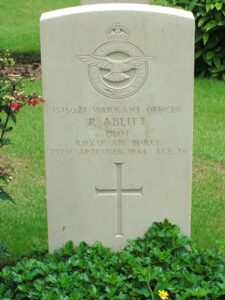
Rhys Henry Evans, Gunner, 1141841, Royal Artillery. Rhys was born on 29 July 1921, the son of Henry Evans, of Howey. He enlisted into the Royal Artillery and was posted to the Far East in January 1945 with the 96th (Royal 1st Devon Yeomanry) Field Regiment. Upon its arrival in the Far East it supported the 81st (West Africa) Division and the 25th Indian Division in preparation for Operation Zipper, part of the operation to recapture Singapore. The Japanese surrendered before the operation was launched, following the dropping of the two atomic bombs at Hiroshima and Nagasaki, so the operation was cancelled. Rhys remained in the Far East after the war and died in Malaya on 17 January 1946, aged 24. He is buried in Ipoh (Connolly Road) Christian Cemetery.
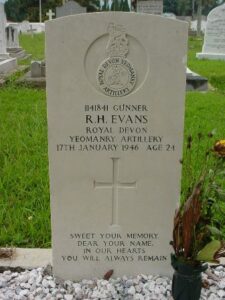
Trevor Rhys Jones, Able Seaman, D/JX639338, Royal Navy. Trevor was born on 10 September 1924, the son of John and Maud Jones, of Howey. He enlisted into the Royal Navy and was based at HMS President III, before being posted aboard the MV Derrycunihy. The ship had been selected to transport A and C squadrons of the 43rd (Wessex) Reconnaissance Regiment, which embarked on 18 June 1944 at West India Docks, London. She arrived off Sword Beach on 20 June, but could not unload due to high seas, so moved to Juno Beach. On the morning of 24 June 1944 Derrycunihy struck a mine which had been dropped by a German aircraft and split in two before sinking. The disaster was the worst loss of life off the Normandy beaches during the campaign, with 183 soldiers and 25 of the ships crew lost. Trevor was just 19 years old when he died that day and is commemorated on the Plymouth Naval Memorial, Devon.
John Edward Price, Fusilier, 14505031, Royal Welch Fusiliers. John was the son of John Edward and Margaret Greta Price, of Howey. He enlisted into the 7th Battalion, Royal Welch Fusiliers. The battalion was attached to the 53rd (Welsh) Division and spent the early years of the war on home service, preparing to take part in the invasion of Europe. John died at Canterbury on 3 December 1943, aged 19. His remains were brought home and John was buried in St. Michael’s Churchyard, Llanfihangel-Rhidithon.